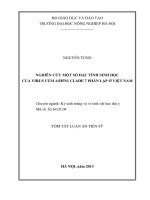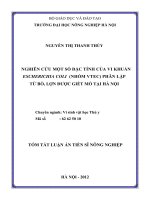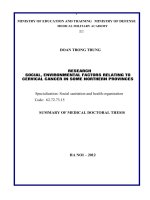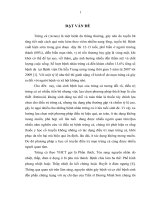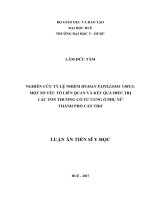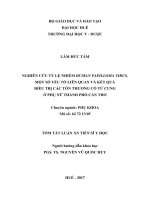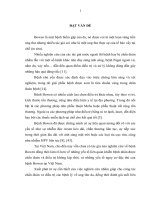tóm tắt luận án tiếng anh nghiên cứu một số đặc điểm lâm sàng, cận lâm sàng, yếu tố liên quan và kết quả điều trị ung thư da tế bào vảy bằng phẫu thuậ
Bạn đang xem bản rút gọn của tài liệu. Xem và tải ngay bản đầy đủ của tài liệu tại đây (214.41 KB, 24 trang )
1
INTRODUCTION
Cutaneous squamous cell carcinoma (SCC), which is about
20% of skin cancer, making it the second most common type of skin
malignancy after basal cell carcinoma (BCC). SCC has higher risk of
recurrence, involve to lymph node and organs metastasis. SCC is a
form of primary invasive skin cancer, arising in the epidermis,
usually on sites of epidermal precancerous lesions (actinic keratosis,
leukoplakia or burn scars) [1],[2],[3].
According to previous researches, factors conferring high
risk for developing BCC are sun exposure, ultraviolet – UV light,
prior cutaneous injuries at tumor site, HPV infection and arsenic
compounds [4],[5],[6],[7].
Currently, the main treatment method is Mohs micrographic
surgery or wide local excision. There were some researches about
SCC which were conducted in Vietnam, mainly focused on
epidemiology, diagnosis, treatment, prognosis, lymph node
metastasis, etc… However, the systematic research which is on
clinical signs, paraclinical, as well as risk factors and SCC treatment,
is still unavailable. Hence, we implement a clinical research of which
the title is: “Clinical and para-clinical manifestations, their related
factors and outcomes of surgery as treatment method for patients
with squamous cell carcinoma”. Aims of the study:
1. Survey some related factors to SCC.
2. Describe clinical and paraclinical features of SCC.
3. Evaluate the results of the SCC treatment by surgery.
RESEARCH SIGNIFICANCE AND CONTRIBUTION
The previous cutaneous chronic inflammation increased the risk of
suffering SCC by 44.59 times. The figure for smoking pipe tobacco
and eating piper betel linn leaf were 21 and 4.95 times, respectively.
There was no relation between SCC and sun exposure, HPV
infection and chemicals. All patient who had historical asthma, were
treated by traditional medicines, appeared the symptoms of longlasting arsenic contaminated. Many cancerous lesions appeared
2
simultaneously and new lesions continuously emerged. Subungual
SCC of the finger which often occurs in the thumb is hard to
diagnosis and need to do multiple biopsy specimens. 8/10 fatalities
from SCC had the appearance of eosinophilia and the absence of
lymphocytes on histopathology. That suggest the high risk of
mortality with the appearance of eosinophilia and the absence of
lymphocytes. Mohs´s Surgery method helps control the recurrence of
cancerous lesions in face, there was only 1 recurrent case after
performing the surgery.
STRUCTURE OF THESIS
This 117-page dissertation which does not include appendix
and reference contains 4 chapters, 45 tables, 12 charts, 5 figures and
14 illustrations. 153 among 166 references are in English and the rest
is in Vietnamese. Composition of the dissertation: 2 pages of
introduction, 33 pages of background, 12 pages of the material and
methods, 36 pages of results, 31 pages of discussion, 2 pages of
conclusion, 1 page of recommendation, and 4 corresponding papers.
CHAPTER I: BACKGROUND
1.1.The skin structure: The human skin is the largest organ in the body.
The skin consists of three primary layers – the epidermis, dermis and
hypodermis. Plakoglobin is located at the epidermis layer, plays a
role in tumorigenesis and metastasis, and may be a therapeutic target
in the treatment of cancer in the future. Lymphocytes, eosinophils
and macrophages in the dermis also participate in the process of
tumor elimination [2],[13] [21].
1.2.
Squamous cell carcinoma (SCC)
1.2.1. Clinical characteristics: The skin lesion is a hard plaque or a nodule,
the color varies from pink to red, may be ulcer in sun-exposed sites,
usually in an existing precancerous lesion. Lymph node and organs
metastasis can occur. There are two major types of SCC: SCCs in
situ and invasive SCCs[7],[26].
1.2.1.1. SCC typical: This is the most common subtype of SCC with 60% of
total cases[38],[39].
3
1.2.1.2. Verrucous squamous cell carcinoma: low malignant potential, slowgrowing tumor, rarely metastasizes [28],[41].
1.2.1.3. Bowen type of invasive SCC: Rare, rapidly growing in a previous
Bowen lesion. Locate in head, neck and extremities [7],[29].
1.2.1.4. Keratoacanthoma(KA): The lesion is a nodule or papule, pink color,
concave at the center. Rapidly growing within 1 -2 months.
Reducing/recovering itself [29],[41].
1.2.1.5. Bowen’s disease: is a local SCC of which lesion is an erythematous,
scaly, well-demarcated. Often arise on sun-exposed surface of the
body such as head and neck[2],[41].
1.2.2. Metastasis: SCC Lymph node metastasis ranges from 0.5% to 6%
[2], the percentage of that of dorsal hand might be up to 60% [10],
[11]. Rarely organ metastasis, if occur usually in lung and bone. The
rate of survival after 1 year of diagnosed with SCC metastasis is
about 56%[48].
1.2.3. TNM classification (AJCC): [50] Significant in treatment and
prognosis. There are 5 stages: stage 0 (Tis, N0, M0), stage I (T1, N0,
M0), stage II (T2/T3, N0, M0), stage III (T4, N0, M0/Tx, N1, M0),
stage IV (Tx, Nx, M1).
1.2.4. Histopathological characteristics: atypical keratocytes, mitosis,
pleomorphic cells, loss of polarity, hyperkeratosis, parakeratosis,
keratin pearls. Tumor cells can penetrate into dermis, vascular,
nerves. Lymphocytes and eosinophilic cells can to present in tumor.
Beside general type, in WHO, it has rare types, including:
Acantholytic squamous cell carcinoma, Adenoid squamous cell
carcinoma, clear cell carcinoma, Spindle cell SCC, Signet-ring cell
SCC,
basosquamous-cell
carcinoma,
verrucous
SCC,
keratoacanthoma [41],[54].
1.2.5. Other tests: SCC metastasis is detected by diagnostic imaging tests
including ultra sound, X-ray, CT scanner, MRI and Pet scans.
1.2.6. Related factors:
1.2.6.1. UV light: this is the most important risk factor in SCC development.
UVB radiation is related to SCC while UVA is
4
associated with basal cell carcinoma and melanoma [55].
1.2.6.2. Human Papilloma Virus (HPV) infection: of more than 200 types of
HPV, some types are high-risk factors of cancer development (16,
18…). The role of HPV in cutaneous SCC pathogenesis is unclear
[59],[60],[61].
1.2.6.3. Gene mutation: there are two groups of cancer-related genes:
oncogenes (XP, MMR, CS…) and tumor suppressor genes (Rb, APC,
p53) )[62],[63].
1.2.6.4. Other factors: chemicals causing cancer (arsenic, tobacco, etc…),
chronic cutaneous injuries (thermal burn, long-lasting non-healing
ulcer, etc…), historical skin cancers, immunodeficiency [1],[7],[67].
1.2.7. Treatment: early treatment and accurate methods are crucial. The
first choice is surgery, including wide local excision and Mohs
micrographic surgery.
1.2.7.1. Surgery: Three principles in order of primary goal include remove
cancerous lesion completely, stabilize the function and aesthetics.
Wide local excision which is considered the first choice, has high
effectiveness with the cure rate is approximately 92% [68]. This
method usually create big skin defects to make difficult to
reconstruction.
Mohs micrographic surgery is a contiguous extension surgery,
which accomplishes in conserving the greatest amount of healthy
tissue while also most completely removing cancer cells. The
indications for Mohs micrographic surgery are high-risk of recurrent
SCC and tissue conservation.
1.2.7.2. Destruction of lesions by physical factors: laser, PDT, cryotherapy,
etc… Indication for local SCC which be able to follow-up.
1.2.7.3. Chemotherapy: topical treatments (5FU, Imiquimod,…), systematic
therapy (cisplatin, 5FU, cetuximab, zalutumumab…)
1.2.7.4. Radiation therapy is used in combination with surgery and
chemotherapy. Radiation might increases the risk of SCC[89],[90].
1.2.7.5. Lymphadenectomy: will be supplied when lymph nodes are detected
by physical examination or using ultrasound. All the lymph nodes
and sentinel node will be removed by surgery method [1],[7]
5
1.2.8. Follow-up after treatment and prevention: Recurrent and metastatic
follow-up every 6 months for at least after 5 years after surgery. Sun
protection.
1.3. Review about SCC in Vietnam and international literature:
Vietnamese studies were conducted mainly in term of clinical
characteristics and lymph node metastasis (Le The Trung (1989),
Pham Hung Cuong, Nguyen Thi Thai Hoa). International studies
mentioned about varied aspects of SCC, however, mostly focus on
epidemiology (Wassberg C) or SCC of the lips (Luiz R. M. S. [35],
Marilda A. M. M. A.[36]…)
CHAPTER II: MATERIAL AND METHODS
2.1. Study population
For 1st and 2nd objectives: 82 patients were diagnosed with SCC
who had received examination and treatment at National Hospital of
Dermatology and Venereology (NHDV).
- Inclusion criteria: Patients who had diagnosis with SCC and
agreed to participate in the research.
- Exclusion criteria: Patients who refused to participate in the
research.
For 3rd objective: Of 72 patients had received surgery, 57 patients
were alive up to the research ended
- Inclusion criteria: patients with SCC, who were selected for two
first objectives, were assigned to surgery and agreed to do the
surgery.
- Exclusion criteria: SCC patients who disagree to do the surgery
or were not assigned to surgery.
2.2. Methods
Study Design overview:
- For purpose 1 and 2: prospective cross-sectional study.
- For purpose 3: intervention, before-after study
Sample size: convenience sampling was used to recruit eligible SCC
patients. There were 82 patients for purpose 1 and 2. For 3 rd purpose,
72 surgical patients were selected from the 82 patients.
6
Location: National Hospital of Dermatology and Venereology.
Duration: From January, 2011 to December, 2013. Follow up the
surgical patients: up to December, 2015.
2.3. Research implementation: The patients, who were suspected
SCC lesion, would conducted histologic examination and
Hematoxyline-Eosine staining. If histopathological confirmation of
SCC, the patients would be re-examined, did other tests and be
collected information according to research’s form (took photo,
completed medical document, followed-up).
2.3.1. Treatment modality:
Mohs micrographic surgery: Mohs micrographic and plastic
surgery were supplemented in 12 patients at operating room, NHDV.
Biopsy specimens were treated, cold-cut, hematoxylin and eosin
stained and interpreted at Histopathological department at National
Hospital of Dermatology and Venerology.
Standard excision: standard excision with a 0,5-2 cm
margin for 51 cases and amputation for 9 cases.
Extensive skin loss coverage: Extensive skin loss was
covered by skin flap, full-thickness skin graft, split-thickness skin
graft.
Regional lymphadenectomy was performed at Operating
room – National Hospital of Dermatology and Venerology when
lymph nodes were found by physical examination or using
ultrasound. Then, a biopsy of the lymph node would be performed.
2.3.2. Follow-up the participants: Participants were followed-up in
terms of infectious complication, hematoma, bleeding, hospitalized
duration, postoperative deformities. From 3 to 6 months of further
complication, recurrent, metastatic after the treatment by physical
examination, abdominal ultrasound and chest X-ray.
2.3.3. Biopsy and PCR test with HPV: biopsy specimens were
collected at Operating Room at NHDV. HE staining and interpreting
results at Histopathological Department of NHDV. 38 samples that
were selected randomly, were performed PCR-HPV test at Molecular
7
biology department of NHDV, the kit was supplied by Viet A
company.
2.3.4. Other tests: Chest X-ray and abnormal ultrasound were
conducted at Diagnostic imaging Department of NHDV. CT scanner
and MRI were performed at Radiology Department of Bach Mai
hospital. Arsenic testing was performed at National Institute of
Occupational and Environmental Health.
2.3.5. Materials:
Materials use for performing biopsy. PCR-HPV: Biopsy
specimens from lesion, chemicals used for HE staining
(Hematoxyline – Eosine), PCR-HPV testing kit tool was supplied by
Viet A company, OTC gel (British Sandon) was used when
conducting cold-cut in Mohs micrographic surgery.
Equipment: Olympus optical microscopes, consumable materials
(non-polar rubber gloves…), cryosection device of Sandon company
2.4. Research endpoints:
2.4.1. Clinical and paraclinical outcomes:
a) Subject features:
Gender, age, occupation, skin type, cutaneous precancerous lesion,
time of SCC detection, reason of examination.
b) Clinical features: TNM classification according to AJCC
(American Joint Commitee on Cancer) in the year 2002. Lesion size
(average, largest, smallest). Lesion characteristics (location, quantity
of lesions, subtype).
c) Histopathological characterization: infiltration of inflammatory
cell, acantholysis, signet ring cells, degree of differentiation of
Border in 1932.
2.4.2. Related factors to skin cancer: Sun light (exposed set level,
time interval of exposure, protection methods). Smocking tobacco,
pipe tobacco and eating betel lin leaf (level, frequency), chemical
exposure (arsenic, pesticides, tar and other chemicals). Cutaneous
precancerous lesions.
8
2.4.3. Surgical outcomes: Comparison of treatment results between
Mohs micrographic surgery and classic surgery (recurrent rate,
metastatic rate, complications, postoperative scar, functional effect,
aesthetic effect). Time of survival after the treatment.
2.5. Data management: Data was imported by Epi-data software
and processed by SPSS 23.0 software. Descriptive analysis was
implemented to investigate the SCC clinical and paraclinical
features, histopathological features, inflammatory cell infiltration of
the lesion. For quantitative variables: mean value and Standard
Deviation. For qualitative variables: frequency and percentage were
used. The ratio of factors related to frequent and percentage which
was analyzed by OR method, were level and the time interval of sun
exposure, sun protection method, level of smoking, smoking pipe
tobacco and eating betel, other chemicals, the relation to previous
cutaneous precancerous lesion. The result of the two surgical
methods. The comparison between the two surgical treatment
outcomes including metastasis, recurrence, scar and functional
recovery were measured by: t test for comparing the two median,
Chi2 test for comparing two ratios, p < 0.05 was considered to
having significant statistic. Rate of mortality and survival, time of
survival after treatment.
2.6. Ethical considerations: The research was conducted at state
facilities, was accept by health staffs at the units and patients.
Patients’ personal information and their health status would be stored
securely.
2.7. Limitation of the research: The number of patients is not large
enough to assess the role of HPV and risk factors of SCC.
CHAPTER III: RESEARCH OUTCOME
3.1. Related factors to SCC
3.1.1. Age and gender
Table 3.1. The relation between age groups and stage of SCC
Age
Stage
0
1
Total
2
3
4
p=0.4
9
<60
1 (1.2%)
≥60
13 (15.9%)
Gender
Male
6 (12.2%)
Femal
e
Total
≤2 cm
>2 cm
3 (3.7%)
13 (15.9%) 1 (1.2%)
0 (0.0%) 18 (22.0%)
10 (12.2%) 32 (39.0%) 7 (8.5%)
2 (2.4%) 64 (78.0%)
3 (6.1%)
p=0.007
32 (65.3%) 7 (14.3%) 1 (2.1%) 49 (100%)
8 (24.2%)
10 (30.3%) 13 (39.4%) 1 (3.0%)
1 (3.0%) 33 (100%)
14 (17.1%)
13 (15.9%) 45 (54.9%) 8 (9.8%)
2 (2.4%) 82 (100%)
Male
7 (8.5%)
42 (51.2%)
Female
14 (17.1%)
19 (23.2%)
Total
21 (25.6%)
p = 0.004
61 (74.4%)
Remark on table 3.1: The disease stage and lesion’s size are
affected by gender (p<0,05).
3.1.2. The relation between occupation and SCC
Table 3.2. The relation between occupation and lesion’s
characterization (n =82)
Lesion’s
Occupation
Total
p
characteristics Out door
In door
Size
≤2 cm
15 (18.3%) 15 (18.3%) 30 (36.6%) 0.171
> 2cm
34 (41.5%) 18 (22.0%) 52 (63.4%)
Stage
0
8 (9.8%)
6 (7.3%)
14 (17.1%) 0.386
1
6 (7.3%)
7 (8.5%)
13 (15.9%)
2
28 (34.1%) 17 (20.7%) 45 (54.9%)
3
6 (7.3%)
2 (2.4%)
8 (9.8%)
4
1 (1.2%)
1 (1.2%)
2 (2.4%)
Total
49 (59.8%) 33 (40.2%) 82 (100%)
Remark on table 3.2: There was no different between the
effect of occupation on the distribution and stage of lesions.
3.1.3. The association between sun exposure and SCC
Table 3.3. The association between sun exposure and SCC
10
The relation between size and level of light exposure (n = 82)
11-14h
Out of 11-≤6h
>6h
Total
14h interval
≤2cm 23 (39.0%) 7 (30.4%) 21 (37.5%) 9 (34.6%) 30 (36.6%)
>2cm 36 (61.0%) 16 (69.6%) 35 (62.5%) 17 (65.4%) 52 (63.4%)
Total 59 (100%) 23 (100%) 56 (100%) 26 (100%) 82 (100%)
p=0.82
p= 0.521
The relation between stage and level of light exposure (n = 82)
0
12 (20.3%) 2 (8.7%)
11 (19.6%) 3 (11.5%) 14 (17.1%)
1
7 (11.9%) 6 (26.1%) 10 (17.9%) 3 (11.5%) 13 (15.9%)
2
35 (59.3%) 10 (43.5%) 28 (50%) 17 (65.4%) 45 (54.9%)
3
5 (62.5%) 3 (13.0%) 5 (8.9%)
3 (11.5%) 8 (9.7%)
4
0 (0%)
2 (8.7%)
2 (3.6%)
0 (0%)
2 (2.4%)
Total 59 (100%) 23 (100%) 56 (100%) 26 (100%) 82 (100%)
p= 0.046
p=0.566
Remark on 3.3: Time interval of light exposure has a relation
with stage of disease (p<0.05) and is not related to size (p>0.05).
3.1.4. Other related factors
Table 3.4: Relationship beween smoking/eating piper betel linn
leaf and lip cancer (n=82)
Tobacco
Yes (n/%)
No (n/%)
Pipe tobacco
Yes (n/%)
No (n/%)
Upper lip
Yes
No
30
1 (1.2)
(36.6)
50
1 (1.2)
(61.0)
11
0 (0)
(13.4)
69
2 (2.4)
(84.2)
Eating
piper Yes (n/%)
1 (1.2) 4 (4.9)
betel linn leaf
No (n/%)
76
1 (1.2)
(92.7)
Yes (n/%)
34
1 (1.2)
(41.5)
p
0.719
0.573
0.009
0.832
Lower lip
Yes
No
4
27
(4.9) (32.9)
4
47
(4.9) (57.3)
3
8 (9.7)
(3.7)
5
66
(6.1) (80.5)
3
2 (2.4)
(3.7)
5
72
(6.1) (87.8)
6
29
(7.3) (35.4)
Total
p
31 (37.8)
0.454
51 (62.2)
11 (13.4)
0.035
71 (86.6)
5 (6.1)
0.000
0.052
77 (93.9)
35 (42.7)
11
Eating
piper No (n/%)
46
betel
linn
1 (1.2)
(56.1)
leaf/smoking
Total - n (%)
80
2 (2.4)
(97.6)
2
(2.4)
45
(54.9)
47 (57.3)
8
(9.7)
74
(90.3)
82 (100)
Remark on table 3.4: Pipe tobacco and eating betel buts are
related to lower lip cancerous lesion (p<0.05).
Table 3.5. Relationship between preexisting lesion and stage of disease
Previous lesion
Normal
AC
AK
XP
Keratosis
Scar burn
Chronic ulcer
Other
Total
Stage
0
9(11.0%)
0(0.0%)
2(2.4%)
0(0.0%)
1(1.2%)
0(0.0%)
1(1.2%)
Tổng
1
5 (6.1%)
0 (0.0%)
4 (4.9%)
1 (1.2%)
2 (2.4%)
0 (0.0%)
0 (0.0%)
2
16 (19.5%)
1 (1.2%)
6 (7.3%)
0 (0.0%)
3 (3.7%)
3 (3.7%)
6 (7.3%)
10
1(1.2%)
1 (1.2%)
(12.2%)
14(17.1%) 13 (15.9%) 45 (54.9%)
3
1 (1.2%)
1 (1.2%)
0 (0.0%)
0 (0.0%)
0 (0.0%)
2 (2.4%)
3 (3.7%)
4
1 (1.2%)
0 (0.0%)
0 (0.0%)
0 (0.0%)
1 (1.2%)
0 (0.0%)
0 (0.0%)
32 (39.0%)
2 (2.4%)
12 (14.6%)
1 (1.2%)
7 (8.5%
5 (6.1%)
10 (12.2%)
1 (1.2%) 0 (0.0%) 13 (15.8%)
8 (9.8%) 2 (2.4%) 82 (100%)
Remark on table 3.5: SCC at stage 2 or 3 is related to burn
scar. SCC at stage 0, 1 or 2 is related to acnitic keratosis.
Table 3.6. The correlation between pre-existing cutaneous
injuries and subtype of disease
Lesion
Local
Invasive
Total
p
Normal
9 (11%)
23 (28%)
32 (39%)
0.03
Precancerous
5 (6.1%)
45 (54.9%) 50 (61%)
3
Total
14 (17.1%)
68 (82.9%) 82 (100%)
Remarks on table 3.6: The rate of SCC infiltration is
increased by precancerous lesions (p = 0.033).
Table 3.7. Relationship between HPV infection and subtype of SCC.
HPV
Type of SCC (n=38)
Total
Marjolin Verrucous Oral SCC Perianal Subungual
area
SCC
Positive 1(2.6%) 1(2.6%) 0(0%) 17(44.7%) 4(10.5%) 1(2.6%) 0(0%)
24(63.2%)
Bowen KA
12
Negative2(5.3%) 0(0%) 1(2.6%) 4(10.5%)
Total
4(10.5%) 2(5.3%) 1(2.6%)
3(7.9%) 1(2.6%) 1(2.6%) 21(55.3%) 8(21%)
3(7.9%) 1(2.6%)
14(46.8%)
38(100%)
Remark on table 3.7: 63.2% of SCC patients had positive HPV
test result. Of these, the rate of HPV infection of verrucous SCC was
the highest.
Table 3.8. The relation between some risk factors and SCC
(Multiple regression analysis)
Risk factors
OR
95% CI
p
Age (60 and above/under 60)
0.58 0.23-1.49
0.261
3
Gender (Female/Male)
1.02 0.40-2.62
0.964
Accommodation (City/countryside)
0.77 0.33-1.78
0.536
Tobacco (Yes/No)
0.80 0.27-2.33
0.682
Pipe tobacco (Yes/ No)
2.53 0.64-10.07
0.187
Eating piper betel linn leaf (Yes/ No)
6.58 0.55-78.43
0.136
Time interval of sun exposure (above/ under 1.14 0.51-2.55
0.751
6h)
Sunlight protection methods (Yes/ No)
0.47 0.14-1.59
0.225
Chemical exposure (Yes/ No)
0.12 0.50-0.31
0.001
Historical skin diseases (Yes/No)
44.95 5.16-391.78 0.001
Remark on table 3.8: Historical skin diseases increased the
risk of SCC by 44.95 times (p = 0.001).
3.2.
Clinical and histopathological features of SCC:
3.2.1. Size of lesions
Table 3.9. Size of lesions by anatomic sites
Smallest Largest Average
SD >2 cm
≤2 cm
Head and neck (n=40)
25 (62.5%) 15 (37.5%)
Size (cm) 0.50
10.00 2.8025 1.92160
Trunk (n=29)
25 (86.2%) 4 (13.8%)
Size (cm) 0.50
23.00 5.0586 4.75466
Extremities (n=27)
21 (77.8%) 6 (22.2%)
Size (cm) 1.00
10.00 4.0217 2.29366
Total (n=82)
61 (74.4%) 21 (25.6%)
Size (cm) 0.50
23.00 3.8207 3.40656
Remark on table 3.9: 74.4% of total lesions was larger than 2 cm.
13
The lesion at head and neck area was smallest, appropriate 3cm
while that of trunk was largest, above 5cm.
3.2.2. Subtypes:
Table 3.10. Subtypes of SCC
Invasive
68 (82.9%) Local
14 (17.1%)
SCC typical
42 (51.2%) Bowen
10 (12.2%)
Perianal
6 (7.3%)
Keratoacanthoma 4 (4.9%)
Marjolin ulcer 6 (7.3%)
Subungual
2 (2.4%)
Perioral
12 (14.6%)
Total
82 (100%)
Remark on table 3.10: Invasive SCC acounted for the larger
part, 82.9% while the figure for local SCC was 17.1%.
3.2.3. Histopathological features:
Table 3.11. Inflammatory cells infiltration
Inflammatory cells
eosionophil eosionophil
mononuclear
(26.8%)
Lympho
Other
mononuclear
Lympho
(73.2%)
Total
n
6
7
9
22
38
82
Tỷ lệ %
7.3
8.5
11.0
26.8
46.4
100.0
Infiltration
Severe
n
21
%
25.6%
Moderate
42
51.2%
Low
19
82
23.2%
100.0
Remark on table 3.11: 51.2% of inflammatory cells penetrated
moderately. 7.3% of inflammatory cells was eosionophil and 46.4% of
them was only lymphocytes.
Table 3.12. Histopathological subtype and differentiation
Histopathological subtype n
Rate
Differentiation
Verrucous carcinoma
43 52.4% Grade 1 38 46.34%
Acantholytic SCC
7
8.5%
Grade 2 23 28.05%
Spindle cell SCC
18 22.0% Grade 3 9
10.98%
Local SCC (Bowen. KA) 14 17.1% Grade 4 12 14.63%
Total
82 100%
Total
82 100%
NonTotal
Good
Poor
cornification
14
Cornificat
44
24
14 (17.1%)
82
ion
(53.7%) (29.3%)
(100%)
Remark on table 3.12: Verrucous carcinoma and good differentiation
counted for the major part of SCC.
Table 3.13: Invasive level of lesion
Invasion
n
%
Vascular invasion Neural invasion
Epidermis
14
17.1%
Papilary dermis 24
29.3% 2 (2.4%)
0 (0%)
Reticular dermis 29
35.3%
Hypodermis
15
18.3%
Total
82 100.0%
Remark on table 3.13: Invasive lesion through reticular
dermis was above 50%. 2.4% was the figure for vascular invasion.
Table 3.14. Other histopathological features
Features
Yes
No
Total
Acantholytic
7 (8.5%)
75 (91.5%)
82 (100%)
Clear cell
11 (13.4%)
71 (86.6%)
82 (100%)
Remark on table 3.14: 8.5% of patients appear acantholytic
in histopathology.
3.3. Treatment outcomes:
3.3.1. Surgery method:
Table 3.15. Surgery by location
Location
Wide
<0.5cm
0.5-<1cm
local
excision 1-2 cm
Amputation
Mohs
Coverage
Local flap
Full-thickness skin
Split-thickness graft
Others
Head and neck (n=35)
Extremities (n=26)
Trunk (n=24)
n
2
9
12
0
12
%
5.7
25.7
34.3
0
34.3
n
1
5
11
9
0
%
3.8
19.2
42.3
34.7
0
n
0
7
17
0
0
%
0
29.2
70.8
0
0
19
6
1
9
54.29
17.14
2.86
25.71
16
5
4
1
61.54
19.23
15.38
3.85
16
3
2
3
66.67
12.5
8.33
12.5
15
Total
35
100
26
100
24
100
Remark on table 3.15: Mohs micrographic surgery was
prioritized on face. Skin flap was often used for coveraging the areas
of extensive skin loss.
3.3.2. Scar after surgery
Table 3.16. Postoperative scar status (n=72)
Bad Scar Morality/lost to
Soft
Keloid
follow-up
Total
≤2 cm excision 9 (12.5%) 2 (2.8%)
5 (6.9%)
16 (22.2%)
Mohs
4 (5.5%)
2 (2.8%)
4 (5.5%)
10 (13.8%)
>2 cm excision 29 (40.3%) 8 (11.1%) 7 (9.7%)
44 (61.1%)
Mohs
2 (2.8%)
0 (0%)
0 (0%)
2 (2.8%)
Total excision 38 (52.8%) 10 (13.8%) 12 (16.7%)
60 (83.3%)
Mohs
6 (8.3%)
2 (2.8%)
4 (5.5%)
12 (16.7%)
Total
44 (61.1%) 12 (16.7%) 16 (22.2%)
72 (100%)
Remark on table 3.16: There was no difference in
postoperative scar status between the surgical methods and lesion
size.
3.3.3. Complication after surgery
Table 3.17. Following up after surgery
Complication
Wide excision Mohs
Total
Non-complication
50 (83.3%)
11 (91.7%) 61 (84.7%)
Skin flap necrosis
1(1.7%)
0(0%)
1(1.4%)
Subsequent infection 9 (15%)
1 (8.3%)
10 (13.9%)
Recurrence
Non recurrence
Local recurrence
New lesion
Metastasis
Non
Lymph nodes
Viscera
Total
49 (81.7%)
7 (11.7%)
4 (6.6%)
11 (91.7%) 60 (83.3%)
1 (8.3%)
8 (11.1%)
0 (0%)
4 (5.6%)
53 (88.4%)
5 (8.3%)
2 (3.3%
60 (100%)
12(100%)
0(0%)
0 (0%)
12(100%)
65 (90.3%)
5 (6.9%)
2(2.8%)
72(100.0%)
16
Remark on table 3.17: The percentage of complication after the
surgery was 15.3%, the major part was infection. Mohs micrographic
surgery was conducted in 8.3% of recurrent patients.
3.3.4. Follow-up period
Table 3.18. Fatality and lost to follow-up
Cumulative
Interval Number Number
Number Number of
Proportion
Start
Entering Withdrawing Exposed Terminal Proportion Surviving
atHazar
Time Interval during Interval to Risk
Events
Surviving End of Interval d Rate
Surgery 0
3
6
9
12
15
18
21
24
27
30
33
36
39
42
45
48
51
54
57
Mohs 0
3
6
9
12
15
18
21
24
60
60
56
50
47
41
40
37
37
31
29
21
20
18
16
13
12
8
3
1
12
12
11
10
10
7
7
6
6
0
4
5
0
4
0
1
0
6
2
7
1
2
2
3
1
4
5
2
1
0
1
1
0
2
0
0
0
1
60.000
58.000
53.500
50.000
45.000
41.000
39.500
37.000
34.000
30.000
25.500
20.500
19.000
17.000
14.500
12.500
10.000
5.500
2.000
.500
12.000
11.500
10.500
10.000
9.000
7.000
7.000
6.000
5.500
0
0
1
3
2
1
2
0
0
0
1
0
0
0
0
0
0
0
0
0
0
0
0
0
1
0
1
0
0
1.00
1.00
.98
.94
.96
.98
.95
1.00
1.00
1.00
.96
1.00
1.00
1.00
1.00
1.00
1.00
1.00
1.00
1.00
1.00
1.00
1.00
1.00
.89
1.00
.86
1.00
1.00
1.00
1.00
.98
.92
.88
.86
.82
.82
.82
.82
.78
.78
.78
.78
.78
.78
.78
.78
.78
.78
1.00
1.00
1.00
1.00
.89
.89
.76
.76
.76
0.00
0.00
.01
.02
.02
.01
.02
0.00
0.00
0.00
.01
0.00
0.00
0.00
0.00
0.00
0.00
0.00
0.00
0.00
0.00
0.00
0.00
0.00
.04
0.00
.05
0.00
0.00
17
27
30
33
36
39
42
45
Non- 0
treatmen 3
6
t
9
12
15
18
21
24
27
30
33
5
4
2
1
1
1
1
10
10
3
2
2
2
2
1
1
1
1
1
1
2
1
0
0
0
1
0
7
0
0
0
0
0
0
0
0
0
1
4.500
3.000
1.500
1.000
1.000
1.000
.500
10.000
6.500
3.000
2.000
2.000
2.000
2.000
1.000
1.000
1.000
1.000
.500
0
0
0
0
0
0
0
0
0
1
0
0
0
1
0
0
0
0
0
1.00
1.00
1.00
1.00
1.00
1.00
1.00
1.00
1.00
.67
1.00
1.00
1.00
.50
1.00
1.00
1.00
1.00
1.00
.76
.76
.76
.76
.76
.76
.76
1.00
1.00
.67
.67
.67
.67
.33
.33
.33
.33
.33
.33
0.00
0.00
0.00
0.00
0.00
0.00
0.00
0.00
0.00
.13
0.00
0.00
0.00
.22
0.00
0.00
0.00
0.00
0.00
Remark on table 3.18: The mortality rate of Mohs
micrographic method at year 1 showed no difference considering that
of year 3.
3.3.5. Survival rate afer treatment
18
Chart 3.2. Survival rate in general
Remark on chart 3.2: The survival rate fluctuated
significantly within 2 first year. The figure was about 10% for each
year.
Chart 3.3. Survival rate for each method.
Remark on table 3.3: At the time of research ended, the
survival rate of surgery group was highest. The difference was
unable to show statistically significant (p = 0.46) with Wilcoxon test.
19
CHAPTER IV: DISCUSSION
4.1. Associated factors with SCC:
The rate of SCC had a tendency to increase with age. The SCC
patients who was beyond 40 years old accounted for 96.3%. The
association between age and the risk of skin cancer due to
accumulation of exposure to carcinogens. The relation between age
and risk of skin cancer due to increasing accumulated exposure to
carcinogens, decreasing the DNA repair capacity (DRC) and
reducing the instant response of the body after DNA destruction to
prevent cancer formation. The estimated proportion of DRC reducing
was around 0.63% per year, down to 25% by the age of 40[92].
Instant responses was expected to decrease by 17% from the age of
30 to 80 [93]. These outcomes was simillar to conclusions of Trinh
Quang Dien (1999), Nguyen Thi Thai Hoa (2002) and Pham Cam
Phuong (2001).
The reason why the percentage of male patient diagnosed with SCC
was higher than that of female patient was the habit of using
sunscreen and skin examination. Size of lesion in male was larger
compare with that of female, and size of lesion in female at stage 0, 1
was larger than that of male. These results had a statistical
significance (p=0.004 and p=0.007, respectively). These outcomes
were also similar to conclusions of Trinh Quang Dien (1999), Miller
(1994), and English (1998) [94],[96],[97].
In this research, 55% of total patient was working outside.
The patients who their sun exposure duration last longer than 6 hours
per day had higher risk of cancer by 2.609 times (p>0.05). The risk
of SCC suffering of the patients who their time interval of sun
exposure from 11h to 14h, was higher by 1.697 times in comparison
to other time interval (p<0.05). This result was similar to that of
Adele Green (1990), Bruce K. Armstrong (2001), Gallagher (1995),
Godar DE. (2005), Rogers HW(2010) [98],[99],[100],[101],[102].
Among SCC patients, 42.7% of them had a habit of smoking
tobacco/pipe tobacco or eating piper betel linn leaf. The relation
20
between these habits to the risk of SCC was not detected. However,
by eating piper betel linn leaf, the risk of SCC suffering at upper lip
and lower lip increased by 19 times and 21 times, respectively
(p<0.05). Smoking pipe tobacco increased the risk of SCC by 4.95
times (p<0.05). This result was similar to that of Grodstein F(1995),
Penelope McBride (2011), Odenbro A(2005), Ling-Ling
Hsieh(2001), Stefano Petti (2013) [37], [111], [112], [114], [115].
All 8.5% of patients who had symptom of long-lasting
arsenic contaminated, had a history of asthma and were treated by
traditional medicine. The researches of Sai Siong Wong (1988),
Linda Lee (2005), Joon Seok (2015) also had similar outcomes.
[116], [117], [118],[119]
Cutaneous precancerous lesions increased the risk of skin
cancer by 44.95 times (p<0.05). W.Tulvatana (2003) showed that the
risk of SCC was rised by 16 times by solar elastosis suffering[123].
More than 5 years of long-standing ulcer, actinic keratosis also
contributed in increasing the risk of SCC [107],[108].
Among 82 participants, 32 patients had received PCR-HPV
test. Of these, 63.2% had positive HPV result. This outcome was
similar to S. Tuttleton Arron’s (2011) [59].
4.2. SCC clinical and histopathological characteristics.
4.2.1. Tumor characteristics
More than a half of total SCC participants was in stage 2.
The total of localized lesion in lips and ears was 17.2%. This fugure
was similar to that of Trinh Quang Dien (1999), Nguyen Thi Thai
Hoa (2001), Wassberg C (2001)[4],[94],[10].
The percentage of lesion of which diameter greater than 2cm
was 74.4%. 60% of lesion size smaller than 2cm located in head and
neck. These figures were higher than that of Nguyen Thi Thai Hoa
(2002), Pham Cam Phuong (2001) while lower than the outcomes of
Igal Leibovitch (2005) [10],[95],[138].
Local SCC in this research, which acounted for 17.1%,
included Bowen’s disease and Keratoacanthoma. The outcome was
21
the same to the study of Cox NH (1994) and different from the
results of Igal Leibovitch (2005)[143].
2 patients (2.4%) suffered from subungual SCC of finger
occured in the thumb. According to Carolina Barbosa (2016) and
Ana Batalla (2014), subungual SCC was rare and easily to be
considered to verruca subungual, therefore the diagnosis usually to
be late[144],[145].
47.6% of total patients had prolong existing ulcer. All of the
lymph node metastatic patients had previous ulcer. According to
Vinicius de Lima Vazquez (2008) and Luiza Vasconcelos (2014), the
risk of metastasis and fatality increased in patients with ulcer[147],
[148].
4.2.2. Histopathological characteristics
In this study, the percentage of lympho cells infiltration was
46.4% and the fugure for eosinophilic cells infiltration was 26.8%
(7.3% of eosinophilia, 19.5% including other type of inflammatory
cells). The histopathological results showed that eosinophilic
infiltration was observed in all cases of metastasis and morality. This
outcomes was similar to the results of P J F Quadvlieg (2006)[51].
The differentiation in degree 1 was 46,43%, in degree 3,4
was 25,61%. Percentage of Verrucous SCC was 58,5%, of spindle
SCC was 23,2% and acantholytic SCC was 8,5%.
4.3. Treatment outcomes:
4.3.1. General outcomes:
16.7% of patients were conducted Mohs micrographic
surgery, whose lesion located in face area. Of these patients, 1 person
relapsed after surgery, there was no patient who had metastasis or
fatal. 83.3% of patients were supplemented wide extension. Of 60
patients who had surgery, 7 cases had repased, 5 case of lymph node
metastasis and 2 cases of organs metastasis. These rate was higher
than the results of Brodland D.G (1992) and was lower than that of
Trinh Quang Dien (1999) [94],[151]. 75% of extensive skin loss
areas were covered by local skin flap method. This proportion was
22
similar to that of Le Tuan hung (1999), Bui Xuan Truong (2005)
while lower than that’s of Bui Xuan Truong (1999) [9],[154], [155].
The figure of complication was 15.3%, bad scars was 16,6%.
This outcome was similar to Tran Van Thiep’s result (2005) and was
higher than that of Le Tuan Hung (1999), Bui Quang Tuyen (2009),
Bui Xuan Truong (1999)[156],[157],[155],[158].
4.3.2. Lymph node and distant metastasis characteristics.
In this research, 5 patients (6.9%) was detected lymph node
metastasis within average 8.8 months. This rate was lower than that
of Vinicius de Lima Vazquez (2008), M . G. Joseph (1992), Pham
Hung Cuong (2005), Trinh Quang Dien (1999) [147],[159].2 patients
(2.8%) were diasgnosed with distant metastasis. This result was
lower than that of Vinicius de Lima Vazquez (2008), Pham Cam
Phuong (2001), was comparable to Pham Hung Cuong’s result
(2005) and was higher than the outcome of Bui Xuan Truong (2005),
Tran Van Thiep (2005) [9],[153],[95],[147],[158].
4.3.3. The rate of survival:
The mortality rate was 17.1%, of these, the percentage of
morality caused by SCC was 13.9%. This figure was lower than the
conclusion of Kay D Brantsch (2008), Gary L. Clayman (2003)
[152], [163]. Disease-free survival rate was 75.4%, similar to the
research of Gary L. Clayman (2003). Disease-free survival rate after
3 years was 77%, which fluctuated within 2 first years with 10% per
year, comparable to the research of Gary L. Clayman [163] and Kay
D Brantsch [153].
The rate of disease-free survival between two methods was
similar (p=0.46). The results comparable to that of Kristina A.
Holmkvist (1998), Melissa Pugliano Mauro (2010) and R. W.
Griffiths (2002) [53],[165],[166].
CHAPTER V: CONCLUSION
Based on the study conducted on 82 SCC patients who were
treated at National Hospital of Dermatology and Venerology, we
figured out:
23
Risk factors:
- Cutaneous precancerous lesion increased the risk of SCC by
44.95 times.
- Smoking pipe tobacco and eating betel linn leaf increased the
risk of SCC of lower lip by 4.95 and 21 times, respectively.
- The relation between other factors (sun exposure, tobacco,
chemicals) and the risk of SCC was unclear.
Clinical and histopathological characteristics
- The proportion of male patients (59.7%) was higher than that of
female (40.2%). The most common age groups was ranged from
60 to 79.
- Ulcers and verruca lesions are 73.2%, 74.4% lesions have size
over 2 cm, and mostly in stage 2 with 54.9%.
- Long-term arsenic contaminated condition increased the number
of lesions and the risk of emerging new lesions.
- The appearance of Eosinophilic and absence of lympho cell were
considered relating to lymph node metastasis (5/5) and mortality
(8/10).
Treatment methods
- Mohs micrographic surgery which were performed on face,
accounted for 16.7%. Using mainly local flap.
- In a series of 16 cases, 1 patient detected metastasis after
supplying lymph node dissection. The common complication
was surgical seam infection.
- There was no difference between rate of mortality and diseasefree survival rate of whom supplemented wide local excision and
Mohs micrographic surgery.
24
RECOMMENDATION
1. When emerging sun damage or chronic inflammation and
ulceration, periodical dermatological examination should be
conducted to make early detection, promptly treatment in
order to avoid metastasis and reduce the rate of mortality.
2. Screening for lymph node metastasis need to be carried out
thoroughly. Further researches, in addition, should be
implemented to decrease mortality rate.
